The Secret Life of Types in Swift
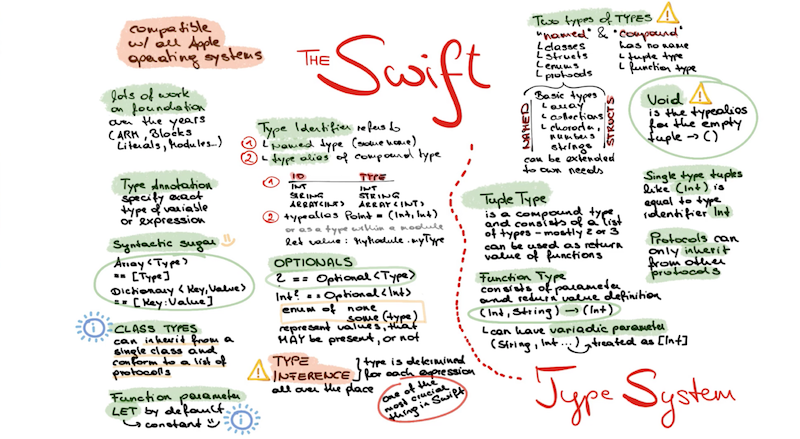
At first glance, Swift looked different as a language compared to Objective-C because of the modern code syntax. Secondly, the strict and strong type system is also different.
This talk takes an under-the-hood deep dive into the Swift type system’s structure and gives tips how to use it in a proper way.
Introduction
I’m Manu, and I will talk to you about data types today. Swift is pretty simple compared to other languages, and Swift is pretty clear in its architecture of the typing system.
It’s All About Types
There are two things to know first. First, Swift says there shall not be root - $noRoot. And we will never have nil.
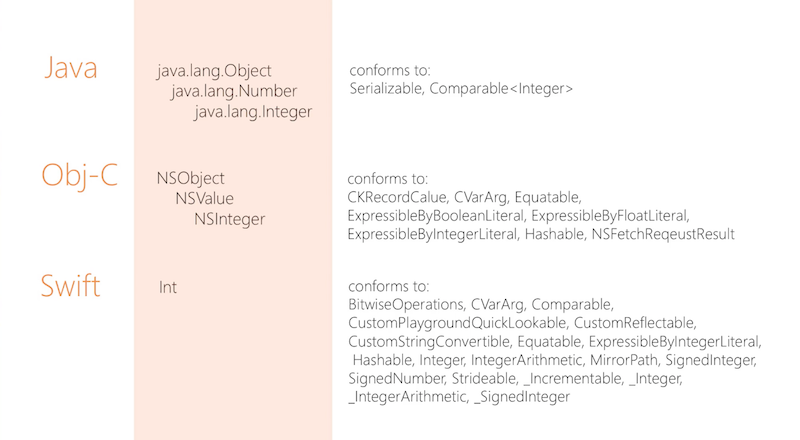
There’s no specific root type in Swift. For example, in other languages like Java, or C#, or static type systems, they have a root type. Swift does not have a root type, and empty values are not allowed.
In Java, an Integer is just a number. The inheritance line is not long, but we do have two stages of inheritance over the type itself, with interfaces, which conforms to a protocol. Objective-C is similar, as it also conforms to a protocol.
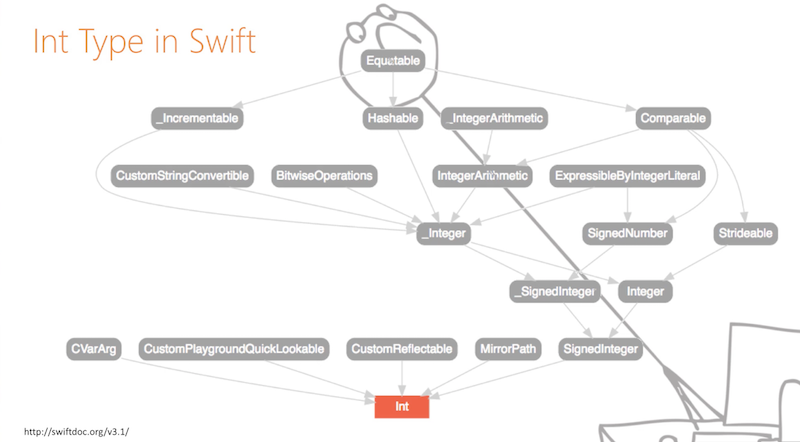
In Swift, Int is a type of itself, and it defines its data types as structures, not classes.
Dive into Types
In Swift, everything is a structure with no inheritance. The reason this is done is so we can have super loose coupling among each type, and can be extended throughout the whole type system. This allows for clean architecture.
Named Types
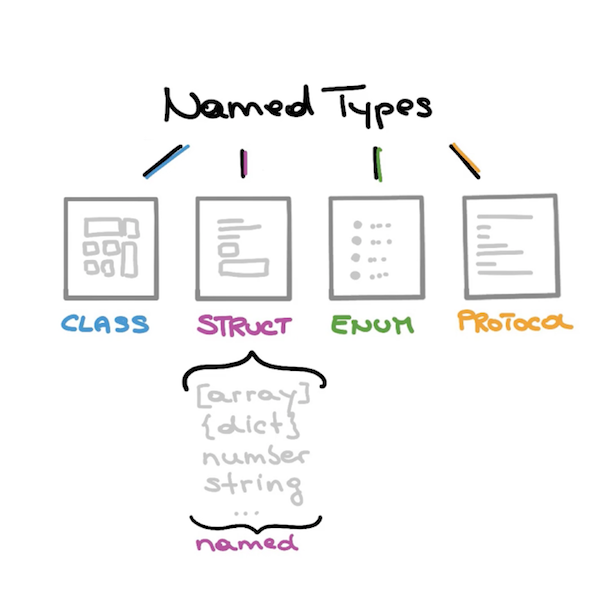
Named types are types that have names. It’s classes, structures, Enums, and protocols; essentially everything you are giving a name when you are using it.
Compound Types
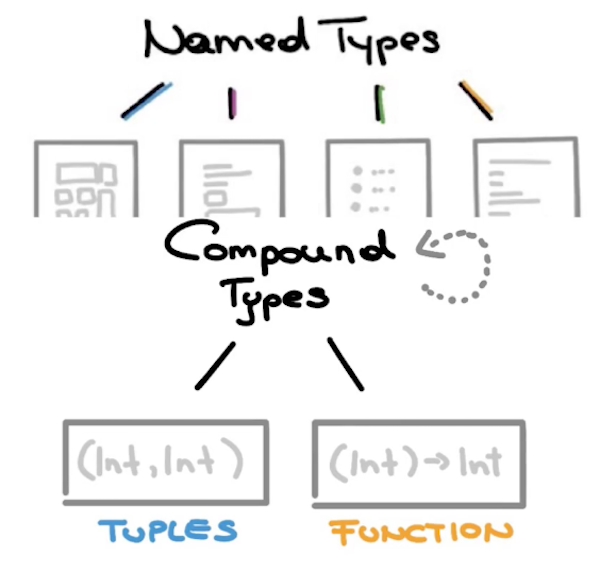
A compound type is a type with no name. The two types of compound types are tuples and functions.
Tuples
This greatTuple variable has exactly the type Int, Int. This is a real type, it just looks like a bit different.
You can attach, or assign a different Int, Int tuple. To do so, leave the parameters, and use the numbers themselves. You can enter the values with the .0, and .1, and so on. Or, you can use the parameter names again.
Let’s continue with tuples, and where they are really meaningful.
Suppose we want to return more than one value from functions. This is done by just defining the types in the return as a tuple.
Tuple types are unnamed but you can give them a name. With the typealias, you can do exactly this.
Here, we are defining a tuple of just two Ints. There is a variable named Point.
Function Types
Like tuples, functions types are also common.
If I want to return nothing, you can get by with writing nothing. The thing exactly after the name of the function, until the first bracket, is the function type.
https://academy.realm.io/posts/altconf-2017-manu-rink-secret-life-of-types-in-swift/?w=1
The Secret Life of Types in Swift的更多相关文章
- iOS: 学习笔记, 值与引用类型(译自: https://developer.apple.com/swift/blog/ Aug 15, 2014 Value and Reference Types)
值和引用类型 Value and Reference Types 在Swift中,有两种数据类型. 一是"值类型"(value type), 它是每一个实例都保存有各自的数据,通常 ...
- swift语言点评十-Value and Reference Types
结论:value是拷贝,Reference是引用 Value and Reference Types Types in Swift fall into one of two categories: f ...
- swift学习笔记1——基础部分
之前学习swift时的个人笔记,根据github:the-swift-programming-language-in-chinese学习.总结,将重要的内容提取,加以理解后整理为学习笔记,方便以后查询 ...
- 理解 OpenStack Swift (1):OpenStack + 三节点Swift 集群+ HAProxy + UCARP 安装和配置
本系列文章着重学习和研究OpenStack Swift,包括环境搭建.原理.架构.监控和性能等. (1)OpenStack + 三节点Swift 集群+ HAProxy + UCARP 安装和配置 ( ...
- Swift互用性:与 Cocoa 数据类型共舞(Swift 2.0版)-b
本节内容包括: 字符串(Strings) 数值(Numbers) 集合类(Collection Classes) 错误(Errors) Foundation数据类型(Foundation Data T ...
- Swift: Associated Types--为什么协议使用关联类型而不是泛型
关联类型的形式为类型的引用进而进行约束提供了条件: 同时能够简化语法形式. Swift: Associated Types http://www.russbishop.net/swift-associ ...
- swift,NSUserDefaults的swift化封装
NSUserDefaultshtml, body {overflow-x: initial !important;}.CodeMirror { height: auto; } .CodeMirror- ...
- swift内存管理:值类型与引用类型
Use struct to create a structure. Structures support many of the same behaviors as classes, includin ...
- 行走于Swift的世界中(转)
从Swift正式公布到现在,我基本一直在关注和摸索Swift.对于一门新语言来说,开荒阶段的探索自然是激动人心的,但是很多时候,资料的缺失和细节的隐藏也让人着实苦恼.最近几天的感受是,Swift 并不 ...
随机推荐
- 企业SDLC建设不成熟设想
一.说明 1.1 背景说明 之前在N市,面试的是“IT系统安全工程师”的岗位但合同上签的是“集成工程师”的名头(前阵子找之前的邮件offer才注意到的),工作内容现在看来还是和当时离职时表述一样基本一 ...
- AQS原理解析 AbstractQueuedSynchronizer
AQS实现原理 https://blog.csdn.net/ym123456677/article/details/80381354 https://www.cnblogs.com/keleli ...
- json文件 乱码问题 根本解决办法
1 工具→自定义:2 点击 命令 标签:3 在上方单选区选中 菜单栏,下拉列表选 文件:4 点击 添加命令5 在类别中,找到文件,在右侧找到高级保存选项,确定6 然后可以通过下移调整该选项在文件菜单中 ...
- (原创)使用C#开发PLC上位机监控系统客户端应用程序
PLC客户端监控系统的特点: 0.客户端系统软件可部署在 多个管理层的PC机上,或者需要部署在距离服务器较远区域的PC机上,通过网线连接到服务器端的交换机. 1应用范围: (1)所有客户端都只有监视功 ...
- 树莓派安装使用docker
2019/11/11, 树莓派4B, Raspbian Buster,Docker 19.03.4 摘要:树莓派Raspbian Buster中安装Docker,Dockerfile更改软件源 安装d ...
- Java线程池定制ThreadPoolExecutor官方定制实例
1.仍然先看构造方法:ThreadPoolExecutor构造方法 public ThreadPoolExecutor(int corePoolSize,int maximumPoolSize,lon ...
- JavaScript---Dom树详解,节点查找方式(直接(id,class,tag),间接(父子,兄弟)),节点操作(增删改查,赋值节点,替换节点,),节点属性操作(增删改查),节点文本的操作(增删改查),事件
JavaScript---Dom树详解,节点查找方式(直接(id,class,tag),间接(父子,兄弟)),节点操作(增删改查,赋值节点,替换节点,),节点属性操作(增删改查),节点文本的操作(增删 ...
- Matlab解释器模式
解释器模式(Interperter),给定一个语言,定义一个语言的文法,并且建立一个解释器来解释该语言中的句子,实际开发中EL表达式或者正则表达式的解释器就是采用这种设计模式.其模式结构如下图.本文使 ...
- Java 之 日期时间类
一.Date类 1.概述 java.util.Date 类 表示特定的瞬间,精确到毫秒. 2.构造方法 public Date():分配Date对象并初始化此对象,以表示分配它的时间(精确到毫秒) p ...
- Java JDBC 数据源
数据源有2种: 普通数据源 即数据库驱动自带的数据源 连接池 包括数据库驱动自带的连接池,以及DBCP.C3P0等常用的第三方连接池. 数据库驱动自带的数据源 //从propertie ...
